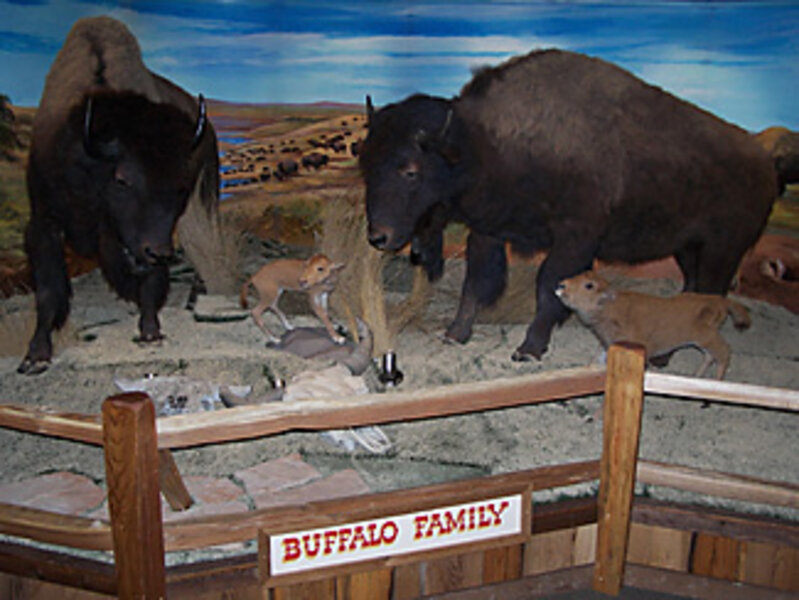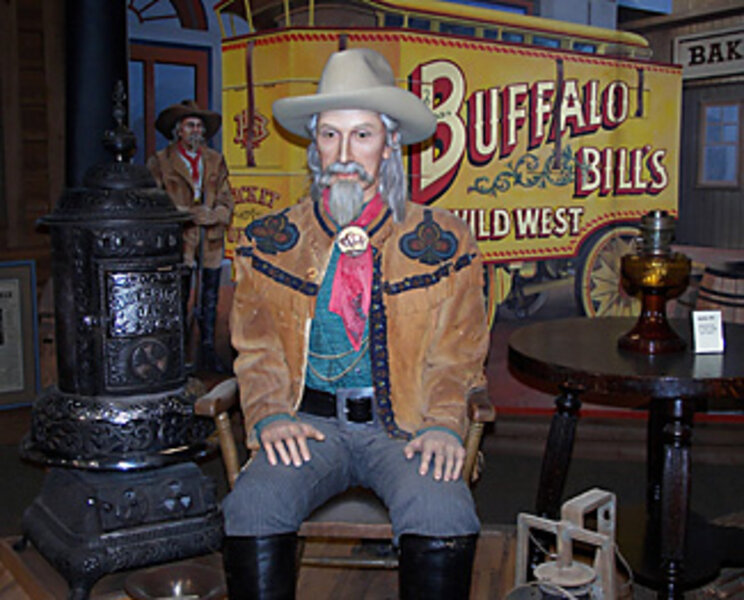In the saddle at the Bison Museum
Loading...
Can you imagine having a collection of something that you like so much that you buy a whole museum's worth of memorabilia? That's what Gary Martinson did! He loves bison collectibles, so in 1999, he bought the Buffalo Museum of America from an Arizona family and added the museum's collection to the one he already had.
Mr. Martinson was always passionate about bison. In fact, he attended North Dakota State University, whose sports teams are called the Bison, or the Thundering Herd.
From there, he began collecting all things bison-related. And he soon realized that images of bison are engraved, painted, imprinted on, or sculpted into things from all over the world.
Mr. Martinson was so enthralled by the American bison and the Wild West that he named his real estate company in Arizona "Bison Homes." And he displayed his collection at Bison Ranch, one of the company's planned communities.
But after a while, the collection grew too large for that location, so he decided to move it to Scottsdale, Ariz., a bigger city. He opened the Bison Museum in October 2007. And he combined all his artifacts and exhibits with the artworks of the Flagg family, who lived in Arizona beginning in the 1950s and were famous for their western-themed paintings and sculpture.
Just what are bison?
You may have heard both "bison" and "buffalo" used to describe the shaggy, brown beasts that once roamed the plains of North America. But true buffalo are native only to Africa and Asia. The animals we know in the United States are properly called bison. Both types of creatures are in the cattle family, but they are physically different. Buffalo, for example, do not have a large hump on their backs as bison do.
Bison can stand up to 6-1/2 feet tall and are about 10 feet long. Male bison (bulls) may weigh up to 2,000 pounds (1 ton!), and females (cows) may weigh as much as 1,100 pounds.
They can run as fast as a horse, up to 35 or 40 miles per hour. So be careful if you happen to meet one on the prairie out West. Bison don't like to be bothered, and they're speedier than you are.
Every bison has a huge hump on its back that is really a large shoulder muscle responsible for holding up the bison's gigantic head. Both cows and bulls have short, curved horns that they use in fighting for status within a herd and for self-defense. They have coarse, dark brown fur on their heads and lighter brown fur on their bodies.
Their skin is very thick, which helps bison keep warm in extremely cold climates. And they are herbivores – meaning that they eat only grass and other plants. In very rare cases, a mama bison may give birth to an entirely white calf. White bison are considered sacred by many native Americans. Mr. Martinson has a white bison head on display at his museum.
Museum tour
When visitors arrive at the Bison Museum, two enormous bronze statues of bison greet them outside the entrance. Inside, there are thousands of things to see: Paintings, sculptures, carvings, dishes, coins, stamps, silverware, badges, toys, and hundreds of other items marked with the bison image fill the display cases and walls. There are also native American artifacts, the art of the Flagg family, and memorabilia from America's Old West of the 1800s.
Sightseers can take a look at a woodcarving of Buffalo Bill and see one of his famous Sharps rifles. William Cody (Buffalo Bill's real name) was known all over America in the late 1800s and early 1900s for his touring Wild West shows. There's even a life-size bison figure that was used as a prop in the 1990 movie, "Dances with Wolves," which included the story of the near-extinction of the North American bison in the late 19th century.
A real hit with kids is the Singing Buffalo Family featuring a mom, dad, and two baby bison singing, "Home on the Range."
The Flagg family art at the museum includes full-size carvings by Dee Flagg of famous men of the Old West, including the Buffalo Bill sculpture and Wyatt Earp and James ("Wild Bill") Hickok. Earp and Hickok were famous gunfighters of their day.
People can also see a life-size carving of an American Indian that Flagg kept with him while he drove a 1914 firetruck around the West selling his wooden creations. A diorama of a saloon and several working player pianos add to the Western flavor of the museum.
The bison tale
As much fun as the Wild West section is, though, the museum's main purpose remains to celebrate bison and the role they played in American history.
Bison were a major food source for several native American tribes of the Great Plains. They not only ate the meat the animals provided but also used the hides, bone, and other parts to make clothing, tools, shelter, and other supplies.
From the 1600s to mid-1800s, there were plenty of bison to go around. About 30 million of them traveled in giant herds across the prairies of North America. Unfortunately, by the late 1800s, bison were hunted almost to extinction. Why did this happen?
Well, during the time when America was expanding west, the US government encouraged white settlers to hunt bison. So they did. Bison were hunted for sport. They were hunted for meat. They were hunted for their hides. (Demand for bison skins and fur was high in Europe and the US.) In addition, bison skins were used for industrial machine belts, clothing, and rugs.
And, sometimes, bison were hunted in order to destabilize native American tribes that depended on the animals. (Many settlers during this time saw the Indians as a barrier to westward expansion.)
Railroad owners also had a stake in bison hunting because if one of these large animals was on a railroad track, it could damage a locomotive or derail a train if it failed to stop in time. When a herd of bison blocked the railroad tracks, which they often did, a train could be delayed for days. People riding the trains would sometimes take aim, fire, and kill bison for sport.
Despite the dwindling numbers of bison, there was no control over hunting them, and soon there were fewer and fewer of them.
As the size of the great herds dwindled, how to protect the bison was discussed by the government and other interested parties, including Theodore Roosevelt, who would later become president of the United States.
Buffalo Bill Cody, who at one time was a bison hunter, spoke in favor of protecting the animals because he feared they would be wiped out. But the attempts to control hunting were ignored and vetoed for a long time.
Then, in 1894, with bison near extinction, Congress finally established a law protecting the species. Their numbers have steadily increased since then, but there are not millions as there once were.
Still, thanks to these many years of conservation efforts, there are a few hundred thousand bison in North America today. Most of them are living in zoos, parks, protected ranches, and on wildlife preserves.
If you find yourself in Arizona anytime soon, you can pay a visit to the Bison Museum to celebrate the good news of the animal's comeback.
The Bison Museum
16641 N. 91st St.
Scottsdale, AZ 85260
Phone: (480) 837-8700
E-mail: bisonmuseuminfo@bisonhomes.com








